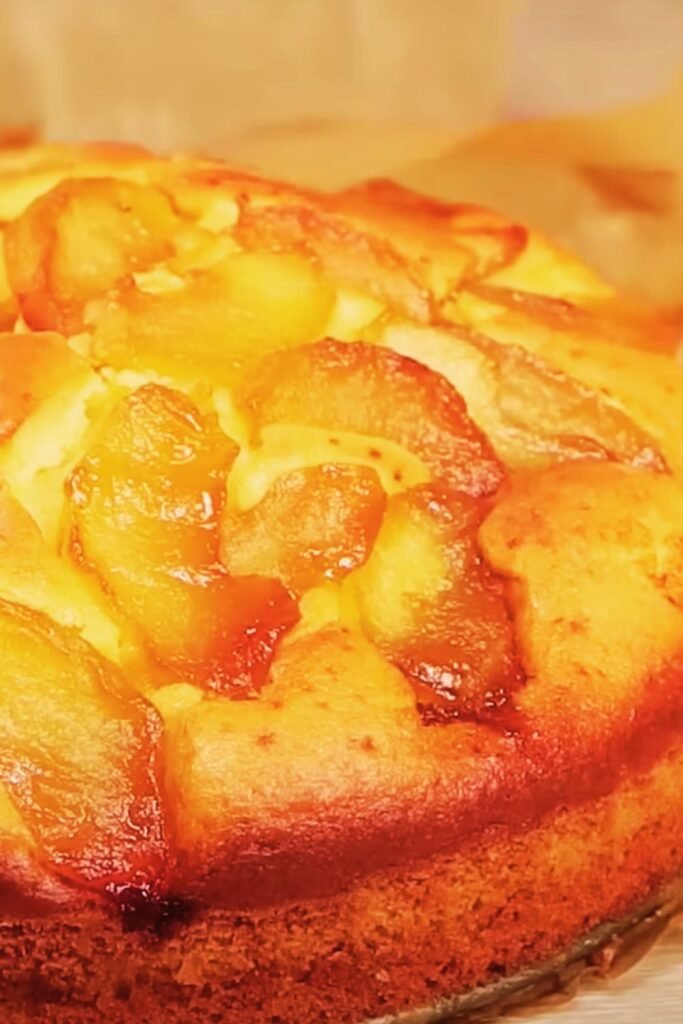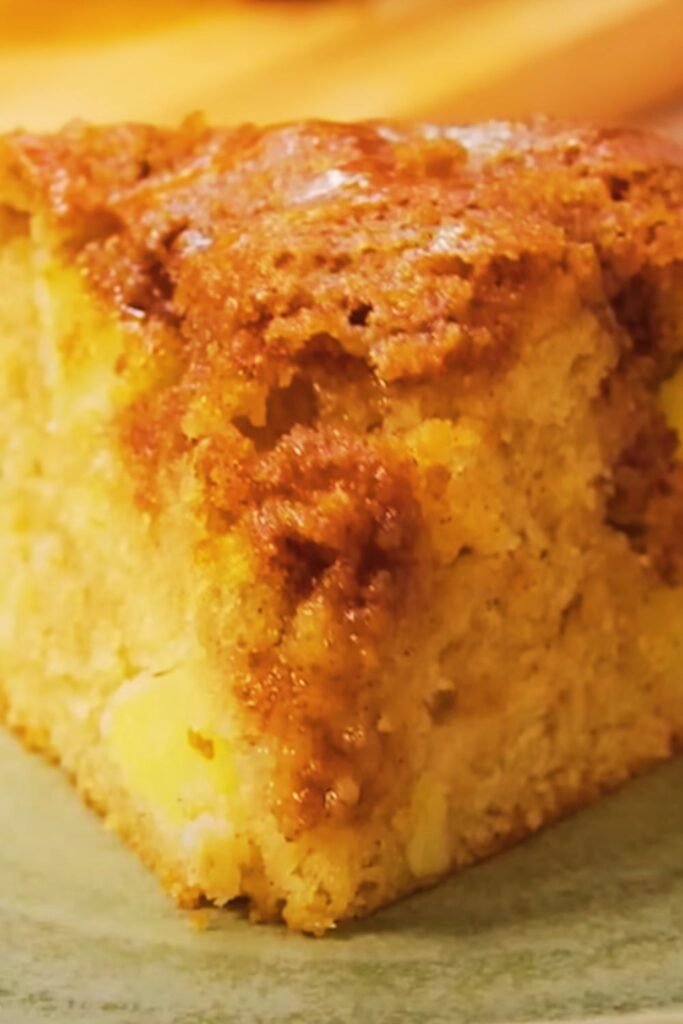There’s something magical about the way a French Apple Cake transforms your kitchen into a Parisian patisserie. I discovered this gem during my culinary adventures, and it has since become my go-to dessert when I want to impress without the fuss. Unlike its American counterparts, this cake celebrates simplicity while delivering extraordinary flavor.
The French Apple Cake, or “Gâteau aux Pommes,” represents everything I love about French baking: minimal ingredients, maximum flavor, and an effortless elegance that makes every slice feel like a celebration. This isn’t just another apple dessert—it’s a testament to how the French have mastered the art of letting quality ingredients shine.
What sets this cake apart is its unique texture and preparation method. Rather than following the traditional creaming method, this recipe embraces a more rustic approach that results in a dense, moist cake where apples take center stage. The batter serves more as a binding agent, creating a dessert that’s part cake, part apple compote, and entirely delicious.
Understanding French Apple Cake: Key Characteristics
Texture Profile : Dense and moist with a custard-like consistency that differs significantly from fluffy American-style cakes
Apple Distribution : Generous chunks of apples throughout, making up approximately 70% of the cake’s volume
Flavor Balance : Subtle sweetness that allows the natural apple flavors to dominate, enhanced by warm spices
Preparation Style : Simple mixing method that doesn’t require special equipment or advanced techniques
Serving Temperature : Equally delicious warm, at room temperature, or chilled, making it versatile for any occasion
The beauty of this cake lies in its forgiving nature. I’ve made countless variations over the years, and each one has taught me something new about this remarkable dessert. Whether you’re a novice baker or someone who’s been baking for decades, this cake will surprise you with its simplicity and depth of flavor.
Essential Ingredients and Their Roles

The ingredient list for French Apple Cake is refreshingly short, but each component plays a crucial role in the final result. I’ve learned through experience that quality matters immensely here—since there are so few ingredients, each one needs to shine.
Primary Ingredients Breakdown
| Ingredient | Quantity | Purpose | Substitution Notes |
|---|---|---|---|
| Apples | 4-5 large | Primary flavor and texture | Use firm varieties only |
| All-purpose flour | 1 cup | Structure and binding | Can substitute with cake flour |
| Granulated sugar | ¾ cup | Sweetness and moisture | Brown sugar adds depth |
| Unsalted butter | ½ cup | Richness and texture | European butter preferred |
| Large eggs | 2 | Binding and structure | Room temperature essential |
| Vanilla extract | 2 teaspoons | Flavor enhancement | Pure extract only |
| Baking powder | 1 teaspoon | Gentle leavening | Fresh powder crucial |
| Salt | ½ teaspoon | Flavor balance | Sea salt recommended |
| Cinnamon | 1 teaspoon | Warm spice note | Freshly ground preferred |
Apple Selection Guide
Choosing the right apples is perhaps the most critical decision you’ll make for this cake. I’ve experimented with numerous varieties, and my experience has taught me that not all apples are created equal for baking.
Best Apple Varieties
- Granny Smith: My personal favorite for their tartness and ability to hold shape
- Honeycrisp: Excellent balance of sweet and tart with great texture retention
- Braeburn: Complex flavor profile that develops beautifully when baked
- Jonagold: Sweet-tart balance with firm flesh that doesn’t break down
Apples to Avoid
- Red Delicious: Too soft and lacks flavor complexity
- Gala: Tends to become mushy during baking
- Golden Delicious: Can become overly sweet and soft
The key is selecting apples that maintain their structure during baking while providing the right balance of sweetness and acidity. I always taste my apples before using them—if they’re delicious raw, they’ll be exceptional in the cake.
Step-by-Step Preparation Method

My approach to making French Apple Cake has evolved over the years, and I’ve developed a method that consistently produces perfect results. The technique differs from traditional cake-making methods, embracing a more rustic, intuitive approach.
Preparation Phase
Equipment Setup
- 9-inch springform pan (essential for easy removal)
- Large mixing bowl
- Sharp knife for apple preparation
- Measuring cups and spoons
- Rubber spatula for gentle folding
Initial Steps
- Preheat your oven to 350°F (175°C)
- Generously butter your springform pan
- Lightly dust with flour, tapping out excess
- Line the bottom with parchment paper for insurance
Apple Preparation Technique
This is where patience pays off. I spend considerable time on apple preparation because it directly impacts the final texture and appearance of the cake.
Apple Cutting Method
- Peel apples completely (skin affects texture negatively)
- Core and cut into ½-inch chunks—not too small, not too large
- Aim for uniform pieces to ensure even baking
- Toss with a tablespoon of flour to prevent sinking
Pro Tip: I always prepare about 20% more apples than the recipe calls for. Some pieces inevitably get eaten during preparation, and having extra ensures you don’t come up short.
Batter Creation Process
The mixing method for French Apple Cake is refreshingly simple, but timing and technique matter.
Wet Ingredient Preparation
- Melt butter completely and let cool slightly
- Beat eggs until just combined—no need for peaks
- Add sugar and whisk until dissolved
- Incorporate vanilla and melted butter
- Mix until smooth and well combined
Dry Ingredient Integration
- Sift flour, baking powder, salt, and cinnamon together
- Add dry ingredients to wet ingredients in three additions
- Fold gently—overmixing is the enemy here
- The batter should be thick but pourable
Assembly and Baking
Final Assembly
- Fold prepared apples into batter gently
- The mixture should look more like apple chunks bound by batter
- Transfer to prepared pan, spreading evenly
- Give the pan a gentle tap to settle contents
Baking Process
- Initial temperature: 350°F for 15 minutes
- Reduce to 325°F for remaining time
- Total baking time: 50-60 minutes
- Test with toothpick—it should come out with just a few moist crumbs
Troubleshooting Common Issues
Through years of making this cake, I’ve encountered and solved numerous challenges. Here’s my guide to avoiding common pitfalls.
Texture Problems and Solutions
| Issue | Cause | Solution | Prevention |
|---|---|---|---|
| Soggy bottom | Excess apple moisture | Pre-salt apples, drain | Choose firm apples |
| Dry texture | Overbaking | Reduce time, check doneness | Use oven thermometer |
| Sunken center | Too much liquid | Measure accurately | Drain apples properly |
| Tough crumb | Overmixing | Fold gently | Mix just until combined |
| Uneven baking | Incorrect pan size | Use specified pan | Level batter carefully |
Doneness Testing Techniques
Determining when a French Apple Cake is perfectly baked requires multiple indicators:
Visual Cues
- Golden brown top with slight spring-back when touched
- Edges pulling away slightly from pan sides
- Surface appears set, not jiggly
Touch Test
- Gentle pressure on center should feel firm but give slightly
- No wet batter visible through cracks
Toothpick Method
- Insert in center—should come out with few moist crumbs
- Completely clean toothpick indicates overbaking
Variations and Adaptations

One of the aspects I love most about French Apple Cake is its adaptability. Over the years, I’ve created numerous variations that maintain the cake’s essential character while adding personal touches.
Seasonal Variations
Autumn Spice Version
- Add ½ teaspoon nutmeg
- Include ¼ teaspoon ground cloves
- Incorporate 1 tablespoon maple syrup
- Substitute brown sugar for half the granulated sugar
Winter Comfort Version
- Add 2 tablespoons brandy or rum
- Include ½ cup chopped walnuts
- Extra cinnamon for warmth
- Serve with warm custard sauce
Spring Fresh Version
- Reduce spices for cleaner apple flavor
- Add lemon zest for brightness
- Include fresh thyme leaves
- Serve with whipped cream
Dietary Adaptations
Gluten-Free Version
- Substitute almond flour for 1/3 of regular flour
- Add xanthan gum if flour blend doesn’t include it
- Increase eggs by one for better binding
- Baking time may need adjustment
Dairy-Free Option
- Replace butter with coconut oil (solid state)
- Ensure all other ingredients are dairy-free
- Texture will be slightly different but still delicious
Reduced Sugar Version
- Cut sugar by ¼ cup
- Add extra cinnamon and vanilla for flavor
- Choose sweeter apple varieties
- Consider adding unsweetened applesauce for moisture
Storage and Serving Recommendations
Proper storage and serving techniques can make the difference between a good cake and an exceptional one. My experience has taught me that this cake actually improves with time.
Storage Guidelines
Short-term Storage (1-3 days)
- Cover tightly with plastic wrap
- Store at room temperature
- Avoid refrigeration if serving within 2 days
- Flavors develop and meld beautifully
Medium-term Storage (4-7 days)
- Wrap in plastic, then aluminum foil
- Refrigerate for best quality
- Bring to room temperature before serving
- Can be gently rewarmed if desired
Long-term Storage (up to 3 months)
- Wrap individual slices in plastic wrap
- Place in freezer-safe containers
- Thaw overnight in refrigerator
- Quality remains excellent when properly stored
Serving Suggestions
Classic Presentations
- Dust with powdered sugar just before serving
- Serve with a dollop of crème fraîche
- Pair with vanilla ice cream for temperature contrast
- Drizzle with warm caramel sauce
Elegant Accompaniments
- Whipped cream infused with vanilla bean
- Custard sauce (crème anglaise) for special occasions
- Fresh berries for color and additional fruit notes
- Chopped toasted nuts for textural interest
Beverage Pairings
- Strong coffee or espresso
- Black tea with a touch of milk
- Herbal teas like chamomile or mint
- Fresh apple cider (hot or cold)
Nutritional Information and Considerations
Understanding the nutritional profile of this cake helps with meal planning and dietary considerations.
Nutritional Breakdown (per serving, 12 servings total)
| Nutrient | Amount | % Daily Value | Notes |
|---|---|---|---|
| Calories | 245 | 12% | Moderate for dessert |
| Total Fat | 8g | 12% | Primarily from butter |
| Saturated Fat | 5g | 25% | Consider portion size |
| Cholesterol | 45mg | 15% | From eggs and butter |
| Sodium | 180mg | 8% | Relatively low |
| Carbohydrates | 42g | 14% | Natural fruit sugars |
| Dietary Fiber | 3g | 12% | From apples |
| Sugars | 28g | – | Natural and added |
| Protein | 4g | 8% | From eggs and flour |
Health Benefits
Apple Contribution
- High fiber content supports digestive health
- Natural antioxidants, particularly quercetin
- Vitamin C for immune system support
- Potassium for heart health
Moderate Indulgence
- Smaller portion sizes satisfy dessert cravings
- Natural fruit provides nutritional value
- Homemade control over ingredients and quality
- Can be part of balanced diet when enjoyed mindfully
Professional Tips and Secrets
After making this cake countless times, I’ve developed techniques that consistently produce bakery-quality results at home.
Temperature Control Mastery
Ingredient Temperature Management
- Eggs should be at room temperature for 30 minutes before use
- Butter should be melted but not hot when added
- Apple temperature doesn’t matter significantly
- Cool cake completely before removing from pan
Oven Management
- Use an oven thermometer to verify temperature accuracy
- Position rack in lower third of oven
- Avoid opening oven door for first 30 minutes
- Rotate pan halfway through if your oven has hot spots
Texture Optimization Techniques
Achieving Perfect Moisture Balance
- Salt apples lightly 15 minutes before use, then drain
- Don’t overmix batter—lumps are acceptable
- Let batter rest 5 minutes before adding apples
- Gentle folding preserves apple pieces
Professional Presentation Tips
- Run a knife around edges immediately after baking
- Cool in pan for 15 minutes before removing
- Use parchment paper sling for easy removal
- Dust with powdered sugar just before serving for best appearance
Frequently Asked Questions
Q: Can I make this cake ahead of time for a party? I absolutely recommend making this cake a day ahead. The flavors develop beautifully overnight, and the texture becomes even more cohesive. Just store it covered at room temperature and dust with powdered sugar before serving.
Q: What’s the best way to prevent the apples from sinking to the bottom? Tossing the apple pieces with a tablespoon of flour before folding them into the batter helps prevent sinking. Also, make sure your batter is thick enough—it should coat the apples rather than being too liquid.
Q: Can I use frozen apples for this recipe? While fresh apples are always preferred, you can use frozen apples in a pinch. Thaw them completely and drain excess moisture thoroughly. The texture will be slightly different, but the cake will still be delicious.
Q: Why does my cake sometimes have a soggy center? A soggy center usually indicates underbaking or too much moisture from the apples. Make sure to test doneness with a toothpick and consider draining your apples if they’re particularly juicy. Also, verify your oven temperature with a thermometer.
Q: Can I substitute different fruits for the apples? Yes, but with adjustments. Pears work wonderfully and require no recipe changes. Stone fruits like peaches or plums need less liquid in the batter. Berries require coating in flour to prevent bleeding.
Q: How do I know when the cake is perfectly done? Look for a golden-brown top that springs back lightly when touched. A toothpick inserted in the center should come out with just a few moist crumbs—not wet batter, but not completely clean either.
Q: What’s the secret to getting the perfect texture? The key is in the mixing technique. Unlike traditional cakes, you want a thick batter that barely coats the apple pieces. Don’t overmix, and remember that this cake should be denser than typical American cakes.
Q: Can I double this recipe for a larger crowd? Absolutely! Double all ingredients and use two 9-inch pans or one large rectangular pan. Baking time may need adjustment—start checking at the original time and add minutes as needed.
Q: Why do some recipes call for more or fewer apples? The apple-to-batter ratio is a matter of preference and regional variation. I prefer a high apple content because it creates that characteristic French texture where the fruit dominates. Adjust to your taste.
Q: How can I make this cake more festive for holidays? For holidays, I add warm spices like nutmeg and cloves, incorporate a splash of rum or brandy, and serve with elegant accompaniments like crème anglaise or caramel sauce. A dusting of cinnamon-sugar before baking creates a lovely top crust.
This French Apple Cake has become more than just a recipe in my repertoire—it’s a reliable friend that never fails to impress and comfort. Whether you’re baking for a special occasion or simply want to fill your home with the irresistible aroma of apples and cinnamon, this cake delivers every time. The beauty lies not just in its simplicity, but in its ability to transform humble ingredients into something truly extraordinary.
The rustic elegance of this cake perfectly embodies the French approach to baking: respect for ingredients, attention to technique, and the understanding that sometimes the most profound pleasures come from the simplest creations. Every time I make this cake, I’m reminded why French baking has captivated home cooks and professional bakers alike for generations.